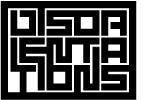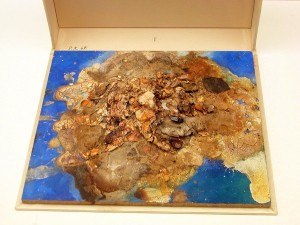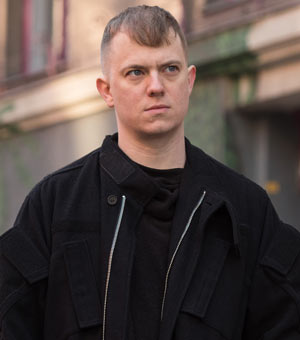Attila Richard Lukacs at Johnen Galerie, Berlin
by Travis Jeppesen on June 1, 2011
The resurgent emergence of the Polaroid photograph as a proper medium in and of itself throughout the last decade can, I believe, be attributed to a social anxiety surrounding the increasing digitalization of practically every vital sphere. The Polaroid inevitably calls to mind an earlier version of accessibility that seems quaint by today’s standards, and thus imbibes the viewer with a sense of nostalgia. There is also a deliberate artlessness native to the technology, a built-in problematic that gives the artist one chance and one chance only to get it right – and even when she does, it is doubtful that the results are going to look all that great. You really have to be both conscious of and content with the qualitative reality of the roughness that comes with the package.
Canadian artist Attila Richard Lukacs first made his name in the late 80s and early 90s with figurative paintings depicting skinheads and thugs in erotically charged portraits and scenes, utilizing classical chiaroscuro contrasts to imbue the images with a sense of timelessness. Occasionally the paintings halted just a few short feet away from kitsch’s front doorstep, and this was accomplished thanks to the not-so-subtle darkness of the content—racist skinheads shaving one another’s heads or wrestling. Some of the paintings were clearly made with the help of models—Caravaggio always comes to mind here, not just because of the chiaroscuro but because the backgrounds are often obscure, when not totally abstract—while in others, Lukacs gleefully allowed his imagination to take a detour beyond the perceptive limits of the real. His is always a seductive escapism, where equal attention has been paid to both the flesh of his subjects and the racy iconography they either flirt with or openly embrace.
There is a sense of loss and ambiguity that perennially haunts Lukacs’s early work, from whence it derives its power. And the city of Berlin—or, to be exact, West Berlin—played a formative role in these paintings, for most of them were created during the ten-year period he resided here, 1986 to 1996. It was a pivotal time of transition for the Cold War-scarred city, and Lukacs was on set in the middle of the action, churning out these beautiful images of Berlin’s disenfranchised young male denizens adrift in a concrete sea of uncertainty.
The current exhibition at Johnen Galerie features not the paintings, but the series of Polaroid photographs Lukacs took that inspired them. Lukacs appears to have taken several dozen Polaroids of each of his models, and they have been compiled on to boards and erected on the gallery walls, providing an interesting study of the period figure, as well as a bevy of clues for devoted fans of the artist. The question of how they rank in importance to the rest of Lukacs’s work, however, remains open. While they were undoubtedly an important part of Lukacs’s process (I use the past tense here because it seems that Lukacs has moved on to abstraction in more recent years), I found myself asking whether it was too much that that process was being revealed in front of me. In addition to hardcore Lukacs fans, the Polaroids might also pique the interest of those interested in Berlin’s recent history and devotees of gay male erotic photography. But otherwise, the aesthetic value of the Polaroids as works of art seems like it is, at best, beginning to fade in rhythm to the decay of the flimsy film on which they are imprinted. If anything, Lukacs’s exhibition points to the limitations of this particular revivalist trend, signaling analog’s sad defeat and indicating that the time has come to say goodbye.
Dust
by Travis Jeppesen on May 9, 2011
“I don’t want a policeman in the room when I’m fucking.”
Bruce Benderson and I discuss the subject of youth in the inaugural issue of Dust, which can be ordered here.
Bruce Benderson and Gary Indiana and Eileen Myles
by Travis Jeppesen on April 26, 2011
It doesn’t matter; there is no matter. Memory doesn’t spit out physical objects, all pristine and shiny. If there is such a thing as a truth in writing, about writing, then it’s always located in the roughness around the edges. The “mistakes.” The hedges.
Rainer Fetting at the Berlinische Galerie
by Travis Jeppesen on April 24, 2011
“Buildings and walls may be erected and razed, but something about the city always stays the same. Gray, sunless Berlin with its sullen, underfed inhabitants who only come out at night. Berlin in dim, chronically underlit bars where you have to squint through an alcoholic haze of stale smoke to find love. Berlin with its manic summers, where sweaty flesh presses against cool foliage in an orgiastic pagan ecstasy of reawakening. The city oozes melancholia more than any other place on the planet. Whatever color and brightness one can find in its craggy grayness can only be attributed to an extraordinary act of willpower, which often manifests itself in Fetting’s palette, revealing both the sensibility of ein Wilder (as he was branded early on by the art establishment) and an eye that is capable of transforming ambiguous emotions into clear forms and cohesive colors through a bewildering act of synaesthesia.”
My essay, “Five Paintings by Rainer Fetting,” appears in the catalog of his current exhibition at the Berlinische Galerie.
Another essay appears in Manscapes, the catalog of Rainer Fetting’s solo exhibition last year at Kunsthalle Tuebingen.
Itchy Homo
by Travis Jeppesen on April 23, 2011
Where the life of the mind is concerned, totalitarianism has already triumphed, and its benefactor has been American-style democracy. This is reflected widely in the “literature” that is most praised and consumed in our culture, a literature that can no longer be considered an art. Enough cynicism, enough irony-coated “minimalism,” enough anti-intellectual hipster posturing. Up with the anarchy of the signifier, with the creation of new myths, with momentary lapses of cognition, with an embrace of psychoses, with an outpouring of unmitigated sexuality—in short, with the freedom that can only be found in the realm of the imaginary. The imaginary, as forged through a “mimetic exacerbation” (again, Hal Foster) of the real.
“Itchy Homo, or Why I am So Terrible” appears in the “Failure” issue of the Review of Contemporary Fiction, which can be ordered here.
Dieter Roth in London
by Travis Jeppesen on April 22, 2011
Stockholm
by Travis Jeppesen on April 21, 2011
At 3am, this is from a much longer work-in-progress, a poem called Europa. About what Europe is and used to be and could be, and who I am with all of it.
This section’s a nakedly summer poem, for those of you who dig that sort of thing. It seems that time will take us there, whether we like it or not, so give in, why don’t you.
George Kuchar in Berlin
by Travis Jeppesen on June 29, 2010
Yes, it’s been a time, and not an easy one at that. Hence, my absence from here for a while.
If you happen to be in Berlin this summer, escape the football hype and retreat indoors to spend a day or two with George Kuchar. This is the highlight of this year’s Berlin Biennale, hands down.
Center of the Earth Gallery in Charlotte to close
by Travis Jeppesen on May 8, 2010
Sad to hear the news about one of my hometown galleries. My earliest exposure to visual art came from this neighborhood, which they nearly singlehandedly pioneered.




